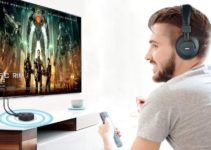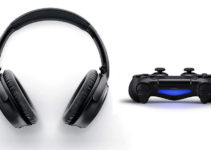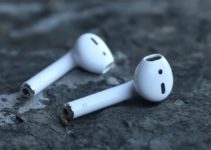As Ferris Bueller once said, ‘Life moves pretty fast’.

It really does.
And it’s noisy too.
Any chance to get back a bit of an escape from it all is all good. Noise cancellation lets you slip into your own world wherever you are, free from intrusive ambient noise clashing with your favorite songs and podcasts.
This guide covers all the cool things ANC does, and how it’s making life even better for headphone wearers everywhere.
In This Guide
What is noise cancellation?
Noise cancellation is a technology you’ll find in modern headphones like the Bose QuietComfort 35 ii that, as the name implies, aims to cancel out ‘noise’ that gets in the way of enjoying your sweet tunes out there in the wide world.
2 main kinds of noise cancellation
There’s two main technologies around at the moment to clean up your audio and get rid of external noise and sound clutter. Active and Passive noise cancellation.
This guide will mainly focus on the active side of things, as that’s what most people are interested in… not to mention it’s the more interesting and cooler of the two options.
Passive noise cancellation
This is an old-school method that audio manufacturers have been using since the dawn of headphones. The idea is simple: build some padding into your headphones that prevents the sound waves from entering into the ear. This, however, is harder to do that it might appear.
Sound waves are notoriously persistent and the human ear can pick up sounds very easily (we’re clever like that).
Active noise cancellation
ANC for short, this is a headphone technology that’s so clever you could pin a tail on it and call it a weasel.
Tiny microphones on the headphones listen to everything that is going on around you. Sounds travel in waves and the microphones detect the sound waves that are coming in to the headphones.
A digital processor then figures out the exact opposite sound wave to the invading one and overlays it over the interference. Doing this cancels out the sound wave resulting (in the best case) in silence.
It works eerily well, and in all kinds of noisy situations. It’s far more effective than the older ‘passive’ kind of noise reduction. There’s pros and cons to each with cost being a main drawback to the Active variety.
Top 5 times you’ll be thankful you’ve got ANC headphones
It’s a noisy world out there. Wouldn’t it be nice to get a few minutes peach with all that chaos going on around you? Here’s some places you can use ANC to get rid of all that noise.
- When all you want to do is enjoy your latte in peace – While most cafes can be an oasis of peace and calm, the truth is they can often be as loud as a bar. Or you get someone with one of those voices on the table next to you… you know the kind.
- On an aeroplane – You’ve downloaded the perfect movie(s) for your flight. On board, all set. Is something wrong? Did you turn it up? There’s no volume! If you’ve ever tried watching a movie on an aeroplane, you’ll know how loud that engine noise is in the cabin. ANC can actually seriously improve this, and can work up to a whopping 80db.
- Walking around on the street – Wind. Car noise. People shouting across the road. And the language (the kids of today!) Tune it all out and provide your own soundtrack to the day. Just be careful when crossing roads!
- Crowded trains & metros – Who loves the morning rush? Getting crammed into a train full of people getting to work. While we can’t do anything about other people squashing up against you on the tube, you can reduce at least some of the stress with some lovely ANC headphones. Play something motivational to get you going for the day.
- At the gym – Everyone’s got headphones at the gym these days, but a lot of people are missing out on getting some serious ANC in their workouts! Most modern gyms will run classes with music blaring as the instructor yells out to the class. Ugh! Give me a break. Get your noise cancelling headphones on and all you’ll hear is that perfect track to give you an energy boost.
Quick video on how noise cancelling headphones work
Smart noise cancellation
If you’re heading out there with your headphones on, you might be wondering, “what happens if I need to actually hear what someone is saying?” Buying a ticket, getting on a bus, talking to an acquaintance, it’s surprising how many time you’ll need to actually use your ears for something other than listening to a new download.
Thankfully, noise cancelling headphones have thought about this. There’s a range or things they do, depending on which set you go for. The best ones can actually detect when someone is speaking to you and will pause playback until you’re done. Handy!
How effective is it?
Active noise cancellation is at it’s best on constant, repetitive noises like engine noises, or the hum you get on a train. It’s not 100% effective in cancelling all sound waves that are flooding into your ears, but it definitely makes a huge difference. If the military invested in it, there’s got to be something to it.
Why you’ll love active noise cancellation
While there’s always a huge list of clever-sounding specifications and features on any set of headphones you buy in 2026, ANC is one you want to take notice of. It’s actually not a gimmick and the tech works extremely well. Being able to cancel out the noise you hear inside of a jet airplane is no mean feat.
Active noise cancellation works very well at getting rid of loud noises, but it’s not 100% perfect. There will still be some sounds that make it to your ear. But it’s still way better than the alternatives out there.
Things you won’t love about active noise cancelling headphones
There’s a few negative things about headphones that use active cancellation:
- It’s not as cheap as passive methods of keeping noise out. If you’re not looking to invest hundreds of pounds into a good set of ANC headphones, you’re unlikely to find a product that does it justice.
- It does have a certain ‘feeling’ to it not everyone will love – Users describe a certain kind of cabin pressure feeling you get when wearing active noise cancelling headphones. Although people do find you get used to it and it goes away after a day. But the tech does have this and it’s something to be aware of.
- It doesn’t cancel out 100% of intrusive sounds – There’s always going to be some sound leakage with headphones and a completely silent experience is just not possible.
What’s the best noise cancelling headphones?
This is an easy one to answer. At the moment you’ve really got a choice of
If you’re in doubt, go for the Bose QuietComfort 35 ii headphones.
Aside from noise cancellation, this is a sterling set of headphones with just unbeatable sound quality and such a good design. They’re tough, they’re super-easy to wear. Find out more about them here.
Today’s best prices on the Bose QC 35 ii
There’s some pretty good deals out there today on Saturday the 10th Jan 2026. Below you’ll find the best places to buy your new soundbar in the UK. These prices are updated regularly. If you find a cheaper price, please let us know in the comments and we’ll make sure it gets added.
Some interesting things you might like to know about noise cancellation!
You can turn ANC off – If you don’t want to have any noise cancellation, or don’t like the sensation, there’s normally a button on the side of the headphones that let you turn it off.
Thanks for checking out this noise cancelling – how it works guide. Got questions? Got comments? Please let us know, down below.
The technology is not new – You’d be forgiven for thinking this is a product of the 2000’s at least, but active noise cancellation was technically invented in the late 1970’s. It’s creator, Amar Bose, founder of the legendary Bose company, was frustrated by how much sound was drowned out on an average air journey. It wasn’t until 1986 that he managed to create a working prototype, however.
ANC was not originally a consumer product – It was a long time before we could get our hands on a pair of headphones that used active noise cancellation. In the beginning it was actually used by airline and military pilots. That’s how good the technology was! Part of the reason for this was how expensive a consumer product would have been.




